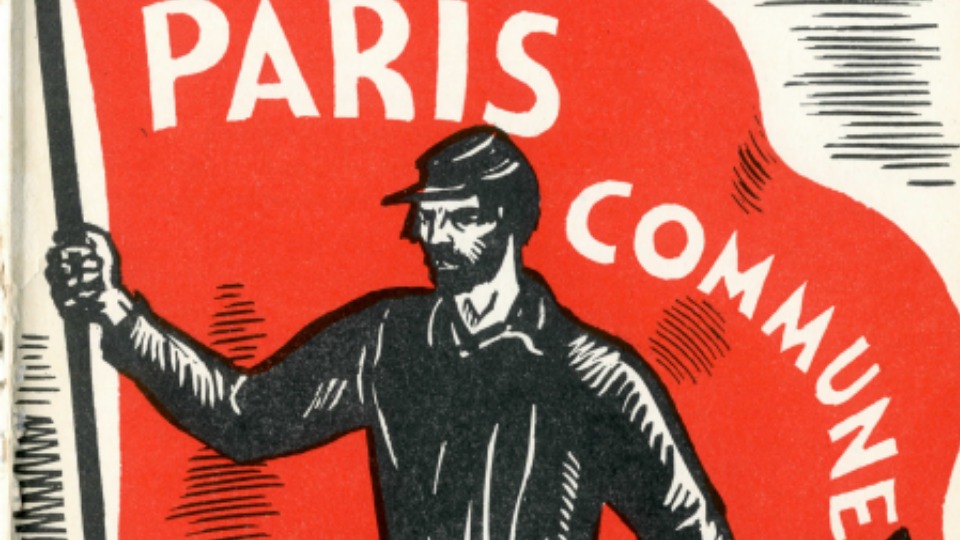
On March 18, Paris arose to the thunder-burst of ‘Vive la Commune!’ […] When ordinary workers dared for the first time to infringe upon the governmental privilege of their ‘natural superiors’… the old world writhed in terror at the sight of the red flag, the symbol of the Republic of Labor, floating over city hall.
— Karl Marx, The Civil War in France
Shortly before dawn on March 18, 1871, several detachments of the French army—recently defeated in the Franco-Prussian war—entered Paris and made their way toward the working-class neighborhoods of Montmartre and Belleville. They were under orders to seize 400 old-fashioned cannons belonging to the city’s civilian militia, the National Guard. In doing so, the conservative government of Adolphe Thiers hoped to neutralize an increasingly militant opposition within the city.

But 19th century Paris, that midwife of revolutions, was not easily pacified. Workers stood up, and soldiers backed down, refusing orders to fire on the people and sometimes even deserting to join them. As the uprising spread, Thiers ordered the evacuation of all troops and personnel, including police, to the government’s seat in Versailles. By sundown, the Central Committee of the National Guard, composed of delegates elected from each neighborhood, controlled the city.
In one nearly bloodless day, the first socialist revolution was victorious. In the days that followed, the Commune abolished child labor, the standing army, and the military draft. It canceled back rent; made schools free, secular, and open to all; prohibited employers from imposing fines on workers; made pawnshops return workers’ tools and household goods; and gave workers’ cooperatives the right to take over businesses whose owners had fled the city. It also laid the basis for a new form of government, where all administrative functions were carried out by elected delegates, paid at workers’ wages, and subject to recall at any time.
“The workers,” wrote Marx, “had no ready-made utopias to introduce par decret du peuple [‘by decree of the people’].” The Commune did not spring fully formed from a manifesto. Rather, it took shape as an ideologically disparate coalition under the political leadership of the working class seeking a solution to a concrete problem: the defense of the French Republic.
The Parisian working class had few illusions about the place reserved for them in the capitalist republic headed by Thiers. Many still remembered the revolutionary struggles of 1848. They had joined with the middle class and a section of the capitalist class to topple the last king of France and replace the monarchy with a republic—only to find themselves locked out and their demands for unemployment relief unanswered. Parliamentary democracy had served only to consolidate the power of the capitalist class.
Ultimately, that power was concentrated in the hands of President Louis Napoleon Bonaparte, who overthrew the republic and crowned himself Emperor Napoleon III in 1852. Marx’s description of his reign is worth quoting at length, both for its verve and for the parallels to the Trump regime:
It professed to save the working class by breaking down parliamentarism… It professed to save the propertied classes by upholding their economic supremacy over the working class; and, finally, it professed to unite all classes by reviving for all the chimera of national glory.
In reality, it was the only form of government possible at a time when the bourgeoisie had already lost, and the working class had not yet acquired, the faculty of ruling the nation. […] Under its sway, bourgeois society, freed from political cares, attained a development unexpected even by itself. Its industry and commerce expanded to colossal dimensions; financial swindling celebrated cosmopolitan orgies; the misery of the masses was set off by a shameless display of gorgeous, meretricious, and debased luxury.
When that disastrous regime collapsed in September 1870, amidst the unfolding debacle of the Franco-Prussian War, the re-establishment and defense of the republic emerged as the most immediate demand of the citizens of Paris. Even as the German army encircled Paris, they flocked to political clubs and discussion circles and organized “vigilance committees” in each district of the city, along with a Central Committee to coordinate among them. The working class took full part in those organizations, which would eventually become the basis for the work of the Commune.

The defense of the republic became more urgent still after the elections of February 9, which produced a government dominated by the Party of Order, a fusion of reactionary monarchist factions representing the wealthiest segment of the ruling class. Marx points out the extent to which the working class had stepped into leadership of the struggle for the republic: “[It] was openly acknowledged as the only class capable of social initiative, even by the great bulk of the Paris middle class… They felt there was but one alternative: the Commune, or the empire, under whatever name it might reappear.”
In this sense, the rise of the Commune demonstrates the continuity between democratic struggle and socialist revolution. The world’s first working-class government did not come to power by overthrowing a capitalist republic. Rather, it stepped into power because only the working class was capable of defending the political and economic interests of the people.

In the end, the Commune lasted only two months. During the “Bloody Week” of May 21-28, the troops of the Thiers government retook Paris and drowned the workers’ republic in blood. The revolution had not succeeded in spreading to the rest of France, let alone in overthrowing the capitalist class. Nonetheless, it represented an enormous political advance for workers. For the first time, ordinary working people had won the ability to make and enforce laws in their own interest. More importantly, they had recognized that working-class power required a different kind of government than capitalist power, and done their best to establish such a government.
Looking at our own situation in the U.S. today through the lens of the Commune, two parallels leap out.
The workers of the Paris Commune realized that the emancipation of labor required both new laws and a new form of government. Similarly, the democratic movement in the United States has now begun to realize that reforms like raising the minimum wage and passing the PRO Act will require institutional reforms as well. Ideas ranging from eliminating the filibuster to packing the Supreme Court, and even abolishing the Electoral College, draw broad support. While this doesn’t exactly put us on the brink of socialist revolution, it does indicate that the struggle for democracy has reached a higher level.
Moreover, just as the Parisian working class took the lead in fighting for the political and economic interests of the people, the U.S. working class is stepping into the forefront of the struggle for democracy. The AFL-CIO champions the rights of undocumented workers and prepares to mobilize in defense of the elections. The Poor People’s Campaign has taken up the struggle for voting rights. A new wave of union organizing, including in Southern right-to-work states, is both rebuilding the labor movement and challenging the Republican Party’s stranglehold on power.
Here again, socialism is not around the next bend in the road, and there are many challenges ahead, especially that of winning over workers who have fallen under the influence of fascism—but the emergence of the working class as a significant force in the struggle for democracy is an excellent sign.
If the Paris Commune has a lesson for our time, it is revolutionary hope: the conviction that the working class and its allies can transform the world. We are on the path toward that goal—perhaps even farther along than we imagine.
Read Marx and Lenin on the Paris Commune—“The Civil War in France”—from International Publishers.













Comments